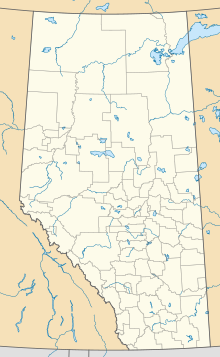
Waterton Park

Waterton Park | |
|---|---|
 View from above of Waterton Park | |
Location of Waterton Park in Alberta | |
| Coordinates: 49°03′06″N 113°54′51″W / 49.0517°N 113.9142°W | |
| Country | Canada |
| Province | Alberta |
| Census division | No. 3 |
| Improvement District | Improvement District No. 4 Waterton |
| Government | |
| • Type | Unincorporated |
| • Governing body | Alberta Municipal Affairs |
| Area (2021)[1] | |
| • Land | 482.54 km2 (186.31 sq mi) |
| Elevation | 1,280 m (4,200 ft) |
| Population (2021)[2] | |
• Total | 132 |
| Time zone | UTC−7 (MST) |
| • Summer (DST) | UTC−6 (MDT) |
| Area code | 403 / 587 |
| highways | |
Waterton Park, commonly referred to as Waterton, is a hamlet in southwestern Alberta, Canada within Improvement District No. 4 Waterton (Waterton Lakes National Park).[3]

It is located at the southwestern terminus of Highway 5, approximately 54 kilometres (34 mi) west of the Town of Cardston and 55 kilometres (34 mi) south of the Town of Pincher Creek. This hamlet is north of Glacier National Park in Montana. It has an elevation of 1,280 metres (4,200 ft).

The hamlet is located in Census Division No. 3 and in the federal riding of Lethbridge.

Demographics
In the 2021 Census of Population conducted by Statistics Canada, Waterton Park had a population of 132 living in 54 of its 195 total private dwellings, a change of 25.7% from its 2016 population of 105. With a land area of 482.54 km2 (186.31 sq mi), it had a population density of 0.3/km2 (0.7/sq mi) in 2021.[2][1]

As a designated place in the 2016 Census of Population conducted by Statistics Canada, Waterton Park had a population of 105 living in 39 of its 168 total private dwellings, a change of 19.3% from its 2011 population of 88. With a land area of 485.66 km2 (187.51 sq mi), it had a population density of 0.2/km2 (0.6/sq mi) in 2016.[14]

Climate
Waterton Park has a humid continental climate (Köppen Dfb), just above the subarctic climate (Dfc). Summers are mild with cool nights, while winters are chilly with highs around freezing. Precipitation is relatively consistent year round, but peaks during the months of May and June.[15]

| Climate data for Waterton Park | |||||||||||||
|---|---|---|---|---|---|---|---|---|---|---|---|---|---|
| Month | Jan | Feb | Mar | Apr | May | Jun | Jul | Aug | Sep | Oct | Nov | Dec | Year |
| Record high °C (°F) | 15 (59) |
17 (63) |
20 (68) |
26.5 (79.7) |
30 (86) |
31 (88) |
34.5 (94.1) |
34 (93) |
32.8 (91.0) |
29 (84) |
19 (66) |
20 (68) |
34.5 (94.1) |
| Mean daily maximum °C (°F) | 0.3 (32.5) |
1.3 (34.3) |
5.3 (41.5) |
10 (50) |
15 (59) |
19 (66) |
22.5 (72.5) |
22 (72) |
17.3 (63.1) |
11.8 (53.2) |
3.1 (37.6) |
−0.3 (31.5) |
10.6 (51.1) |
| Mean daily minimum °C (°F) | −10.6 (12.9) |
−9.8 (14.4) |
−5.5 (22.1) |
−1.5 (29.3) |
2.8 (37.0) |
6.1 (43.0) |
7.9 (46.2) |
6.9 (44.4) |
3.4 (38.1) |
0.6 (33.1) |
−5.8 (21.6) |
−9.7 (14.5) |
−1.3 (29.7) |
| Record low °C (°F) | −40.5 (−40.9) |
−50 (−58) |
−34.4 (−29.9) |
−24.4 (−11.9) |
−11 (12) |
−6 (21) |
−3 (27) |
−5 (23) |
−12 (10) |
−27 (−17) |
−34 (−29) |
−44.5 (−48.1) |
−50 (−58) |
| Average precipitation mm (inches) | 59.3 (2.33) |
46.3 (1.82) |
69.3 (2.73) |
64.5 (2.54) |
94.5 (3.72) |
80.8 (3.18) |
70.8 (2.79) |
69 (2.7) |
60.8 (2.39) |
65.1 (2.56) |
68.7 (2.70) |
58.4 (2.30) |
807.6 (31.80) |
| Source: Environment Canada[16] | |||||||||||||
See also
References
- ^ a b c "Population and dwelling counts: Canada and designated places". Statistics Canada. 9 February 2022. Retrieved 10 February 2022.
- ^ a b c "Population and dwelling count amendments, 2021 Census". Statistics Canada. 1 December 2023. Retrieved 22 September 2024.
- ^ "Specialized and Rural Municipalities and Their Communities" (PDF). Alberta Municipal Affairs. 3 June 2024. Retrieved 14 June 2024.
- ^ Census of Canada 1966: Population (PDF). Special Bulletin: Unincorporated Places. Vol. Bulletin S–3. Ottawa: Dominion Bureau of Statistics. 1968. Retrieved 25 September 2024.
- ^ 1971 Census of Canada: Population (PDF). Special Bulletin: Unincorporated Settlements. Vol. Bulletin SP—1. Ottawa: Statistics Canada. 1973. Retrieved 25 September 2024.
- ^ "Geographical Identification and Population for Unincorporated Places of 25 persons and over, 1971 and 1976". 1976 Census of Canada (PDF). Supplementary Bulletins: Geographic and Demographic (Population of Unincorporated Places—Canada). Vol. Bulletin 8SG.1. Ottawa: Statistics Canada. 1978. Retrieved 26 September 2024.
- ^ 1981 Census of Canada (PDF). Place name reference list. Vol. Western provinces and the Territories. Ottawa: Statistics Canada. 1983. Retrieved 26 September 2024.
- ^ 1986 Census of Canada (PDF). Population. Vol. Unincorporated Places. Ottawa: Statistics Canada. 1988. Retrieved 26 September 2024.
- ^ 91 Census (PDF). Population and Dwelling Counts. Vol. Unincorporated Places. Ottawa: Statistics Canada. 1993. Retrieved 26 September 2024.
- ^ 96 Census (PDF). A National Overivew: Population and Dwelling Counts. Ottawa: Statistics Canada. 1997. Retrieved 26 September 2024.
- ^ "Population and Dwelling Counts, for Canada, Provinces and Territories, and Census Divisions, 2001 and 1996 Censuses - 100% Data (Alberta)". Statistics Canada. 15 August 2012. Retrieved 19 September 2024.
- ^ "Population and dwelling counts, for Canada, provinces and territories, and designated places, 2006 and 2001 censuses - 100% data (Alberta)". Statistics Canada. 20 July 2021. Retrieved 19 September 2024.
- ^ "Population and dwelling counts, for Canada, provinces and territories, and designated places, 2011 and 2006 censuses (Alberta)". Statistics Canada. 8 February 2012. Retrieved 19 September 2024.
- ^ a b "Population and dwelling counts, for Canada, provinces and territories, and designated places, 2016 and 2011 censuses – 100% data (Alberta)". Statistics Canada. 8 February 2017. Retrieved 13 February 2017.
- ^ Canada, Environment and Climate Change (19 January 2011). "Canadian Climate Normals 1971-2000 Station Data - Climate - Environment and Climate Change Canada". climate.weather.gc.ca. Retrieved 19 May 2020.
- ^ Environment Canada—Canadian Climate Normals 1971–2000, accessed 23 March 2010
See what we do next...
OR
By submitting your email or phone number, you're giving mschf permission to send you email and/or recurring marketing texts. Data rates may apply. Text stop to cancel, help for help.
Success: You're subscribed now !

